Back pain is just a symptom, an external manifestation of some disease or pathology.Every pain has its cause.There are many causes of back pain.
Patients are often told that back pain is caused by overuse of muscles and ligaments.Unfortunately, if the cause was only in the muscles, then it would be very easy to relieve the pain.For example, a massage that should bring relief.But massage does not always help because it removes the cause of the pain.
Acute back pain can occur due to a herniated disc or a bulging disc.If the herniated disc is on the right, you may experience right-sided back pain, right-sided pain, or right-leg pain (sciatica with large herniation).If the hernia is left-sided, then you may feel back pain on the left and may be bothered by pain on the left side.
If the hernia is large and compresses the left lumbar root (rhizitison the left), then a lumbago may appear in the left leg and pain may begin in the left leg.A large hernia often causes a violation of body posture in the form of trunk deformation with acute "twisting" pain, when it is impossible to straighten and straighten (the so-called antalgic position of the trunk).
Pain in the lower right back can be the result of problems with a hernia or with the right joints of the spine or pathology of the sacral area (right iliosacral joint).
Pain in the area of the left shoulder blade (or pain under the left shoulder blade) can be a consequence of a hernia or joint pathology, or as a result of heart problems.Such pain can be caused by angina and heart attack.Pain between the shoulder blades occurs not only with pathology of the spine and osteochondrosis, but also with diseases of the stomach (gastritis, ulcers, cancer, etc.) and often of the intestines.
Cholecystitis and cholelithiasis most often cause right back pain and pain under the right shoulder blade.Gallbladder pathology often manifests itself as pain under the right side.They need diagnostics.
Protrusionsdisks, are more often incidental findings on MRI, whichcanproceed without any pain.Herniated disc– is not such a common cause of severe back pain.Although the formation of a hernia, for example, when lifting heavy objects, causes lumbar or thoracic lumbar (acute back pain).In case of constant back pain, the hernia found on the MRI may have nothing to do with it.The reasons for such constant pain are often different. Diagnostics will help you figure it out.
Therefore, to effectively treat back and lower back pain, you must:
- Determine the cause of lower back pain (make a diagnosis).
- The cause of low back pain will be determined by a neurologist, an orthopedic traumatologist with skills in spondylology and spondyloneurology, or a spondylologist (spinal neurologist).The diagnosis is made using clinical and material examination.
- Treatment tactics for low back pain depending on the diagnosed cause.
- If you have lower back pain, it is important to ensure that the pain does not reoccur.To achieve this, we offer several methods, including physical rehabilitation of the spine.
Pain in the lower back.Why does my back hurt?
Low back pain refers to pain located in the area between the 12th pair of ribs and the gluteal folds.Pain of this kind is already a social problem.The fact is that the lower back is the most loaded part of the spine, which withstands daily and hourly overloads.85% of people have experienced low back pain at least once in their life.What is the reason?
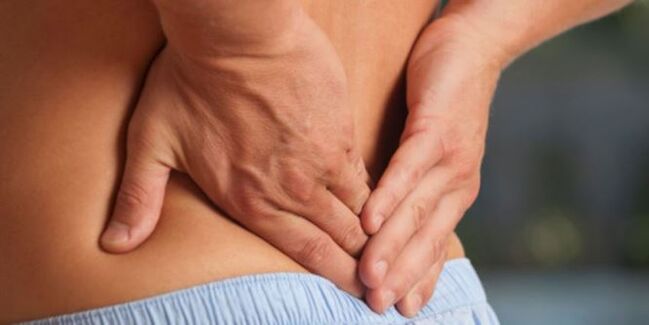
Pain in lumbar regionit can have many reasons.The most common causes are osteochondrosis, disc herniation, radiculitis and lumbar joint pathology.
Osteochondrosis
Osteochondrosis–natural aging of spinal tissue.
It is generally accepted that osteochondrosis is a sign of spinal disease, which is accompanied by pain.This is a little different.
The image below shows that a normal disk has been damaged (see damaged disk in the image).These lesions can accelerate the aging of the disc and lose its height (see "narrowing of the intervertebral space").Then aging begins to affect the bone tissue of the vertebrae itself, and osteophytes develop (see "osteophytes" in the picture).
In the past, it was believed that osteochondrosis was associated with pain.Therefore, at that time they tried to explain the cause of pain in the spine and lower back, especially with osteochondrosis.For this reason, the question of the failure of spondyloneurology even arose.In 1978, the first research laboratory for the problems of vertebral osteochondrosis was created, studied the topic of osteochondrosis for more than 10 years and proved that the cause of pain is not osteochondrosis, but joint pathology.
Osteochondrosis is not accompanied by pain because the disc has no nerve endings.Therefore, there is no pain with osteochondrosis.
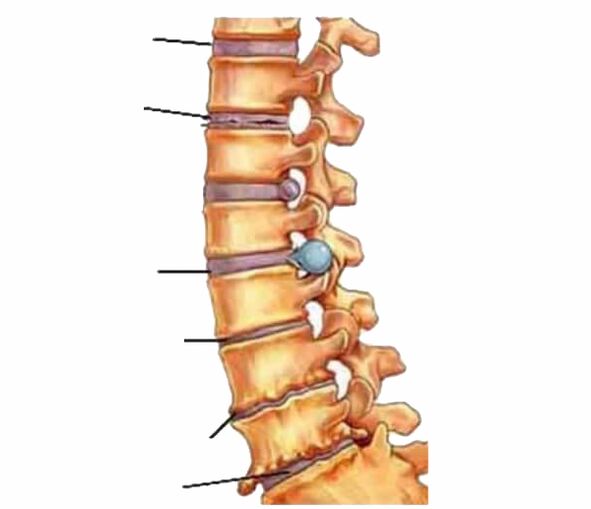
Herniated disc
Disc herniation as a possible cause of pain.The image above shows several herniated discs - a small hernia (bulge) and a large herniated disc.The herniated disc itself does not hurt.

The disc has no nerve endings (they are not innervated).Disc herniation or protrusion pain occurs when the herniated protrusion puts pressure on the innervated tissue.For example, onspineor upbackyuulongitudinalwowbundlesat.In the first case, radicular pain occurs - radiculitis (see below).In the second, when the receptors of the posterior longitudinal ligament are irritated, back pain (lumpondenia) or sharp pain - back pain (lumbago) occurs.
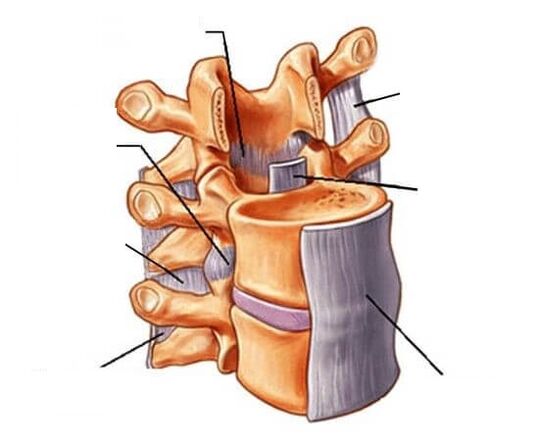
A herniated disc can often be treated without surgery.
Spondyloarthritis
Spondyloarthropathy is the arthropathy of the joints of the spine.Arthritis itself is characterized by disease of the cartilage of the joints.In this case, the cartilage decreases in height (degenerates, "dries up") and the articular surfaces of the bones lose their protective cartilage layer.The joints of the spine begin to ache.This pain feels like lower back pain.
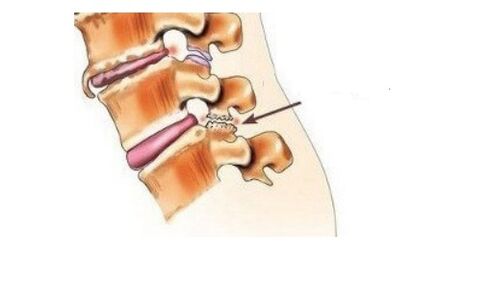
Rhizitis
Rhizitis is an inflammation of the root.Ricitis most often occurs when the root is injured by a herniated disc or vertebral joints.It's usually not so much lower back pain as leg pain, buttock pain, and pain or numbness even in the toes.

Rhizitis is most effectively treated by releasing the root.If it occurred due to a herniated disc, you need to reduce the herniation, which puts pressure on the root.
Pain in the back and lower back due to pathology of the internal organs
Back pain is possible due to pathology of internal organs.For example,lower back pain in womenit can be a consequence of diseases of the pelvic organs.
Lower back pain in women
Lower back pain in women can be caused by inflammatory diseases of the female genital organs.
If a woman has pain in the pelvis and lower back, then you should always remember gynecology.Inflammatory diseases of the female genital organs are not uncommon.The cause can be inflammation of the appendages, inflammatory diseases of the vagina and vulva, salpingitis, salpingophoritis, endometritis, bacterial vaginitis, etc.More often, such inflammatory diseases in women are caused by infections of the genital area, including sexually transmitted infections.
If the waist aches and hurts and at the same time there is pain in the lower abdomen, then the woman needs to be checked by a gynecologist.It is imperative to undergo a gynecological ultrasound to initially clarify the diagnosis.
Constant nagging pain in the lower back also occurs whenoncology in gynecology.
Cancer and low back pain in women
Cancer does not hurt at first.When pain occurs in the lower back or in the sacral area, it may already be too late.
Many people believe that tumors are accompanied by pain.This is wrong.In the early stages of tumor growth, a person does not feel pain.The person feels practically healthy.For example, cervical cancer is asymptomatic in the genitals.It begins to manifest itself when the tumor grows.In this case, the pain often occurs in the lower back and under the lower back.The pain under the lower back is in the area of the sacrum.
With cancer, severe lower back pain doesn't bother you at first.Probably the lower back doesn't hurt, but it does.Such pain can be the first call that will help a woman prevent the critical growth of the tumor and make a correct diagnosis in time.If the lower back or the sacrum constantly hurts, you should pay special attention to it so as not to miss a catastrophe.
Unfortunately, if you do not pay attention to pain or discomfort in the lower back, the next sign of cervical cancer can be uterine bleeding.This is the stage at which the tumor begins to disintegrate, when metastases may already be present.Including the spine, when there is already severe pain in the lower back.
Important takeaway:if your lower back hurts, it's not necessarily osteochondrosis or a herniated disc.And it never hurts to have a preventive consultation with a gynecologist.After all, the erosion of the cervix detected during the examination is a precancerous condition.
Why does my lower back hurt from urological or genitourinary problems (inflammations)?
Acute lower back pain may be due to kidney disease
The lower back hurts badly with a kidney disease like pyelonephritis.
Pyelonephritis is an infectious disease, most often caused by an ascending infection.It can be associated with both sexually transmitted infections and other types of household infections transmitted through swimming pools, baths and personal hygiene items.For example, everything lives in unwashed towels for a long time.
Inflammation activates pain receptors in the soft tissues of the pelvic organs.The pain signal (impulse) reaches the spine through the sensitive roots, activating its tissues.The soft tissues of the spine and the attachment points of the back muscles become swollen (inflamed) reflexively.And my back is starting to hurt.
Constant pain in the back and lower back due to dysfunction and other diseases of the gastrointestinal tract
With intestinal spasms, with bloating, with ulcers or ulcerative colitis, with stomach ulcers and gastritis, the back usually hurts.
Stomach cancer associated with back pain
Back treatment for pain caused by gastrointestinal pathology will not provide improvement.The cause must be addressed.
Another possible cause of lower back pain is overloading the back
Excessive load on the lower back is a common cause of back pain or flare-ups.Overuse often affects the lower back joints, back ligaments, tendons or muscles.In addition, the muscles in the lower back work actively under load.Therefore, if you have lumbar spine pain after exercise, it is not necessarily an illness.It could be a muscle tear.If this pain does not subside within 1-2 days, then you should think about problems with the lumbar spine.Especially if this pain is aggravated by movement.
The causes of such pain are often overloaded inflammation of the muscles and their attachments.Or – inflammation of the joint capsules.
If such an exacerbation occurs more than once a year, you should look for the cause of such exacerbations.To do this, it is not enough just to consult a doctor and do manipulations, take painkillers, massage and other procedures.
Investigation is needed to determine the cause of such frequent exacerbations.
Soft tissue injury of the back
Severe pain in the lower back when you move awkwardly or when you lift something heavy is probably a spinal injury.
If you are concerned about pain on this side, for example, pain in the lower back on the right, then you should think about the pathology of the joint located on the right.Or for a right-sided hernia of the lumbar spine.
Types of lower back pain
The pain, taking into account the duration, can be acute, chronic or have a (passing) transistor character.
The pains are as follows:
- Local pain– pain exclusively in the lower back.
- Referred pain– when the pain occurs not only in the lower back, but for example in the buttock, in the pelvic area.Or, the pathology of the internal organs causes pain in the lower back.In such cases they speak of referred pain.
- Radical pain– differ in significant intensity, and are located within the limits of the root innervation (from the spine to the periphery).The cause is a violation (stretching, compression, curvature, compression) of the nerve root of the spinal nerve.Movement or even coughing increases the pain due to the so-calledimpulse to cough.This is severe lower back pain that can radiate (radiate) down the leg.
- Myofascial pain– is the result of a reflex muscle spasm.The causes of myofascial pain can be diseases of internal organs or damage to the spine itself.Muscle spasm significantly disrupts the biomechanics of human movements.Chronic muscle spasms can also cause pain and cramping in low back pain.
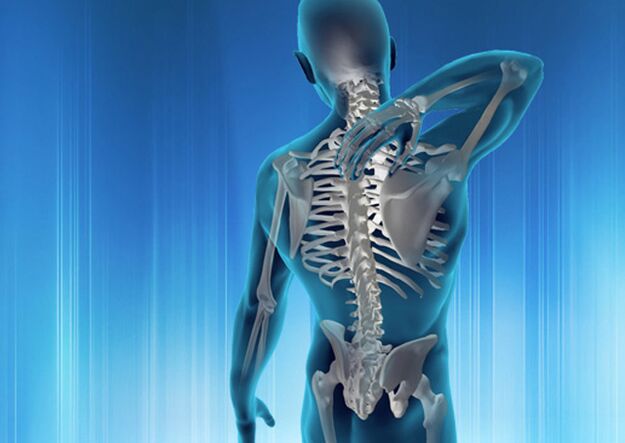
In which cases should you consult a doctor for lower back pain and what to do?
- with sharp (sharp) pain in the lumbar region.
- if the back or lower back pain continues for more than 3 days.
- if back pain occurred after an injury.
- if the pain is located simultaneously in the lower back, leg and lower leg.
- if pain in the lumbar region is combined with numbness in the thigh, buttock, leg, leg, groin.
- if the pain in the lumbar region is accompanied by contractions (contractions) of the muscles of the limbs.
- if the function of urination and defecation is impaired (urinary retention, incontinence, frequency or false urge to urinate).
- if the perineum is numb.
- If back or lower back (sacrum) pain is constant, worse in the morning
What to do if you have lower back pain?
The causes of back pain are varied, so the treatment of back pain should only be carried out after the diagnosis and after the diagnosis has been made by a qualified doctor.Any pain in the region of the vertebrae requires a medical examination and clarification of the cause of its occurrence.
Visiting the doctor has 3 goals:
- Get the correct diagnosis.
- Eliminate pain.
- Formulate measures to help maintain the patient's health so that the pain does not recur.
Possible causes of lower back pain
The following diseases may be the cause of your complaints of lower back pain:
- osteochondrosis;
- osteoarthritis;
- spondylolisthesis;
- spondylosis;
- ankylosing spondylitis;
- spondyloarthropathy;
- muscle damage;
- ligament damage;
- herniated disc "HerniaThe disc is treated without surgery in 98% of cases (world statistics)";
- atherosclerosis of the abdominal aorta.
- malignant neoplasms of the spine;
- spinal metastases;
- urinary tract infections;
- spinal stenosis;
- diseases of the biliary tract;
- invasive duodenal ulcer;
- pancreatitis;
- kidney disease;
- anatomical aneurysm of the abdominal aorta.
- bleeding into the retroperitoneal tissue;
- inflammatory diseases of the female genital organs;
- oncological diseases of the female genital organs;
- endometriosis;
- prostatitis;
- prostate cancer;
- Abscess of the epithelial duct of the coccyx;
- embolism of the arteries of the lower extremities;
- intermittent lameness;
- pseudo-intermittent claudication;
- neutralizing atherosclerosis of the vessels of the lower extremities.
- rheumatoid spondylitis;
- polymyalgia rheumatica;
- fibromyalgia
- depression;
- other.
Treatment of lower back pain (lumbago)
At the stage of initial treatment with pain in the lower back (back), a primary diagnosis is made.This is done based on research, medical history, neurological and orthopedic examinations.At this stage, drugs may be prescribed to reduce pain, relieve tissue swelling and general anti-inflammatory treatment.Reflexology, local medicinal effects, regional anesthesia, various injection methods to treat lower back pain, laser therapy, etc.they are effective.In the acute and subacute period, rest is important during drug therapy.Physiotherapy, massage, manual therapy are not recommended, as they may worsen the process.In the acute period, traction is also not used: material, on inclined boards, on wall bars.
To treat lower back pain more effectively, you need to understand the cause.For this purpose, the patient is further examined to clarify the diagnosis.There can be many causes of pain in the lumbar region.An indicative list of diseases accompanied by lower back pain is listed above.Each of them has its own treatment protocol with a list of the most effective approaches, drugs and procedures.The protocols also contain data on methods that are not indicated for this disease.For example, for inflammatory diseases of the spine (spondylitis, spondyloarthropathy, spondyloarthritis, myositis, ligamentitis, etc.), manual therapy, massage and physiotherapy are not indicated due to ineffectiveness and risk of complications.It is necessary to identify the cause of the inflammation and treat it.
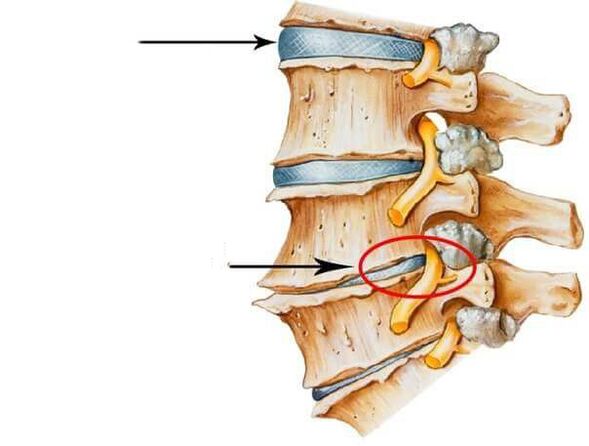
Spondylosis visible on radiographs can occur without clinical symptoms and often masks a more complex disease.Therefore, the treatment of spondylosis is useless and often dangerous: it is unrealistic to remove bone growths in the spine and there is no need.The patient may face exotic diagnoses such as 'muscle damage', 'muscle spasm',"connective damage".Unfortunately, talking about muscle spasms as the cause of pain is not always true.Muscle spasm of the paraspinal muscles is a reflex action and, as a rule, accompanies most diseases, including those not related to the spine.The muscles are actively involved in the segmental reflex process and can respond to any irritation both inside and outside the spine.The so-called "spasms" must be differentiated from the reflected or projective pain in the lower back, which can be caused by pathology of the internal organs: diseases of the pelvic organs, retroperitoneal space, kidneys, pancreas and prostate glands, gynecological diseases of inflammation or tumor, diseases of the aorta, bleeding in the posterior tissue.Osteopathic techniques for working with secondary spasmodic paraspinal muscles can, on a reflexive level, temporarily relieve the condition.Manual therapy, osteopathic techniques, incline plank, massage, traction, physiotherapy, for example, will not help prostatitis or adenomatosis."Therapeutic removal" so-called.The "muscle spasms" in this case are simply the desires of the operator.
Treatment of herniated and bulging discs in the lower back
Often, an MRI will reveal a hernia or protrusion, which is interpreted as the cause of low back pain.The question immediately arises: remove the hernia or try to treat it without surgery?
The first thing you should do– specify how clinically significant this hernia is.The fact is that if you take 100 perfectly healthy people without back pain and do an MRI diagnosis, it turns out that 80% of them have some kind of disc protrusion ("herniation"), which does not give any symptoms.
Often, a herniated disc can be an incidental finding, often attributed to another cause of pain.
At the same time, practice shows that not all hernias are clinically significant.To clarify the causes of pain, a detailed medical history is taken, a neurological examination is carried out to identify neurological deficits, the function of the pelvic organs is clarified, etc.
It turns out that not all herniated and bulging discs need to be operated on.Patients who need such an operation do not exceed 2%.
Neurosurgeons have prescribed absolute indications for surgery, which are clearly defined.Most of the time, the presence of a herniated disc is not a reason for emergency surgery.
There is a sufficient arsenal for the treatment of herniated and bulging discs, including traction, the formation of stable movement patterns in the back, methods of local and general drug therapy, physiotherapy, reflexology, etc.Graded treatment without surgery is often accompanied by resolution of symptoms, and the hernia (protrusion) may decrease over time.
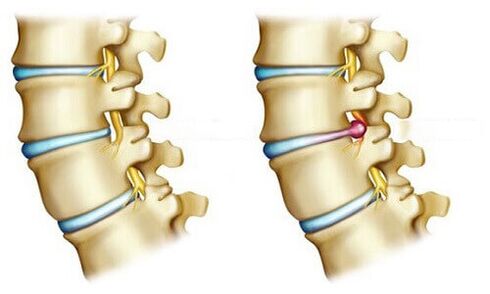
When making a decision about surgery, the relevant indicators for surgical treatment, which are officially defined by neurosurgeons, must be taken into account.Each specific case is considered individually, taking into account clinical symptoms, medical history, anamnesis, neurological and orthopedic examinations, the results of material and laboratory tests.
In particular, it should be noted that surgery is often associated with a number of complications, which after the operation must be treated many times more intensively than the pain relief before the operation.
Degenerative changes in the spine, such as osteochondrosis, spondyloarthritis, spondylosis, etc., are treated based on the identification of the triggers of the pain syndrome.
Massage and manual therapy are quite effective treatment methods if there are indications for their use.Over the past three decades, the Institute has developed optimal protocols for the management of patients with low back pain, taking into account the possible range of causes.


















































